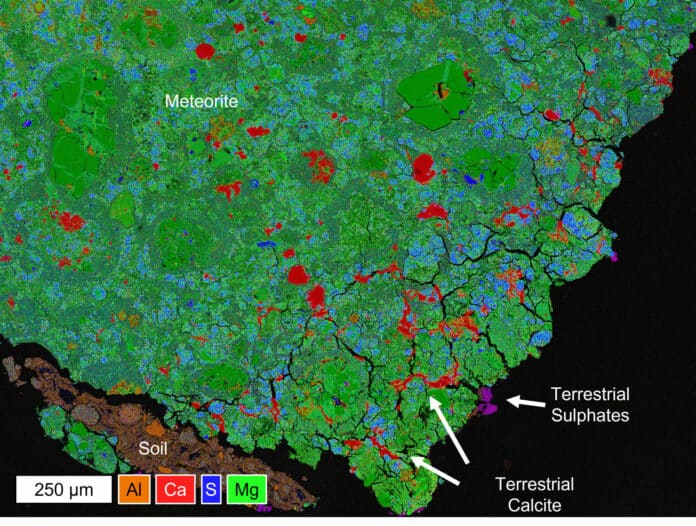Winchcombe is a CM chondrite that fell in Gloucestershire on February 28, 2021. Although some fragments were recovered on March 1, 2021, within 12 h of the fall, others took weeks to find, with the last documented fragment being collected on April 1, 2021.
A new analysis of the Winchcombe meteorite shed light on how fast the Earth’s atmosphere affects the space rocks that fall to Earth. The study, led by Laura Jenkins, a Ph.D. student at the University of Glasgow‘s School of Geographical & Earth Sciences, shows that despite the meteorites’ rapid recovery, the shards immediately formed multiple “terrestrial phases”—salts and minerals—from their surfaces interacting with the moist environment where they fell.
When a meteorite is exposed to terrestrial contaminants, it changes the information it provides.
In their study, scientists examined two small pieces of Winchcombe for signs of terrestrial modifications. They examined the samples’ surfaces using transmission electron microscopy, scanning electron microscopy, and Raman spectroscopy. Two samples were collected: one from the driveway fragments and the second from those discovered in the sheep field.
The fusion crust of samples from sheep fields was found to have two forms of salt- sulfates of calcium and calcite. On the other hand, the samples from the driveway found to have halite, also known as table salt.
When meteorites melt during their ferocious entrance into the Earth’s atmosphere, a peculiar substance called the fusion crust is created. The scientists concluded that since the sulfates were found on the fusion crust’s exterior, they most likely formed after the object touched down due to exposure to the moist conditions of the sheep field.
Halite, meanwhile, was only visible on the polished surfaces of the driveway portion. Since the polishing was done after the meteorite was recovered, it was likely formed by the interaction of the rock slice with the humid laboratory air.
Jenkins said, “The Winchcombe meteorite is often described as a ‘pristine’ example of a CM chondrite meteorite, and it’s already yielded remarkable insights.”
“However, what we’ve shown with this study is that there’s no such thing as a pristine meteorite – terrestrial alteration begins the moment it encounters Earth’s atmosphere, and we can see it in these samples which we analyzed just a couple of months after the meteorite landed.”
“It shows just how reactive meteorites are to our atmosphere and how careful we need to take this kind of terrestrial alteration into account when we analyze meteorites. If possible, meteorites should be stored in inert conditions to minimize terrestrial alteration.”
“Understanding which phases are extra-terrestrial and which are terrestrial in meteorites like Winchcombe will not only help our understanding of their formation but will also aid in relating meteorites that have landed on Earth to samples returned by sample return missions. A complete picture of the asteroids in our solar system and their role in Earth’s development can be built.”
Dr. Luke Daly, a co-author on the paper, said, “We’ve always known that exposure to Earth’s atmosphere affects the surface of meteorites, but this is the first time we’ve been able to see just how quickly the process can begin and advance.”
“We were very lucky to be able to recover the Winchcombe meteorite so quickly through the monitoring of the UKFall network and the efforts of the volunteers who helped us recover the largest pieces from the field.”
“This research shows just how vital it is to keep watching the skies and assemble search parties as quickly as possible after meteorites are spotted.”
Journal Reference:
- Laura E. Jenkins, Martin R. Lee et al. Winchcombe: An example of rapid terrestrial alteration of a CM chondrite. Meteoritics & Planetary Science. DOI: 10.1111/maps.13949
